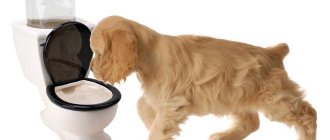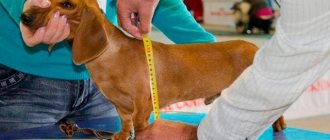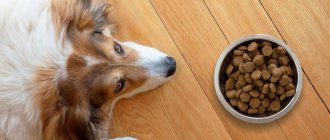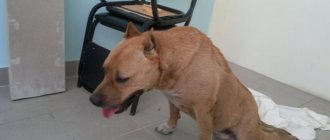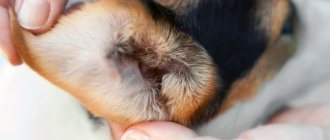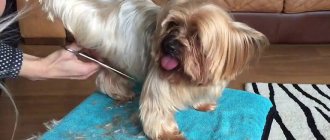In this article I will talk about constipation in dogs and what to do. I will describe the main symptoms and reasons why the puppy cannot go to the toilet for the most part. I will list possible methods of helping your pet and what medicine to treat constipation at home. And is it necessary to resort to surgery?
Constipation is difficult, systematically insufficient bowel movement (defecation), characterized by a small amount of feces, increased hardness and dryness.
What is considered constipation in a dog?
Constipation in dogs is incomplete, irregular, severe, or completely absent bowel movements:
- According to general estimates, stool with a frequency of twice every 3 days or pain that occurs in a dog during defecation at a normal frequency can already be considered constipation.
- With constipation, stool accumulates in the intestines, which can dry out, harden and cause not only discomfort in the pet, but also cause injury to the intestinal wall.
- Constipation occurs quite often in dogs, especially in older animals, in animals leading a sedentary life, and also in all ages after feeding the dog bones.
Etiology.
Constipation in dogs can be caused by:
- Violations associated with diet and feeding:
- Feeding the dog table scraps.
- Insufficient amount of fiber and ballast substances in food.
- Feeding with dry food with a small amount of fluid entering the body.
- Feeding food cooked in strong broths or monotonous food.
- General overfeeding of the dog.
- Giving your dog plenty of bones.
- Dehydration.
- Obesity and sedentary lifestyle.
- Rare walks.
- Incorrect use of medications - constipation after diarrhea (side effect after long-term use of astringents).
- Dog disease:
- Diseases of the digestive system (peptic ulcer in dogs, hemorrhoids in dogs), liver (liver disease in dogs) and kidneys (urolithiasis in dogs).
- Recovery of dogs after infectious diseases (canine parvovirus enteritis, canine distemper).
- Fractures of the pelvic bones.
- Inflammation, swelling, abscesses of the prostate and paraanal glands (prostatitis in dogs).
- Blockage of the intestines with foreign objects (bones, toys).
- Volvulus.
- Intestinal atony.
- Worms (worms in dogs).
- Dysbacteriosis of the large intestine.
- Tumors in the intestines or perineal area (oncology in dogs).
- Diseases of the nervous system accompanied by paralysis and paresis.
- Injuries in the spine.
Dog nutrition recommendations
To treat poor bowel movements, dietary adjustments are necessary. The diet should not contain:
- rice, beans, corn;
- rich broths;
- cheeses;
- muscle meat;
- dry food;
- bones;
- fatty food;
- whole milk;
- fresh bakery.
Food is given in small portions in warm and liquid form. Overfeeding the dog is unacceptable. Olive (or other vegetable) oil added 1-2 drops to food will help improve intestinal motility.
Improves bowel function:
- porridge with water or milk:
- fresh or stewed vegetables (carrots, beets, pumpkin);
- boiled sea fish fillet;
- fermented milk products without additives;
- cabbage juice;
- fresh plums or prunes (no more than 2 pieces).
It is strictly forbidden to feed your dog food from your table!
Consequences that a dog may have as a result of prolonged constipation
The consequences of prolonged constipation are quite serious. As a result of prolonged constipation, a dog may experience:
- general intoxication of the body;
- rupture of the intestinal wall;
- disturbances in the functions of internal organs and systems;
- the load on the heart increases;
- Impaired nutrition of the skin, followed by the appearance of itching in the dog (itching in dogs), scratching, and areas of baldness.
* if a dog’s intestines do not empty within 4-7 days, then death occurs.
Clinical picture . Constipation in a dog is manifested by the following main clinical signs:
- the dog strains strongly when trying to defecate, there is difficulty defecating, or the dog’s owners note frequent urges without bowel movements;
- the excreted feces have a dry, hard consistency, feces are sometimes released in small quantities;
- pain, discomfort, accompanied by whining or restlessness of the dog when attempting to defecate;
- due to gas accumulations in the intestines, bloating is noted; upon palpation, the abdomen is hard;
- lack of bowel movements due to lack of feces;
- lack of appetite;
- general state of oppression.
In the case when constipation in a dog is accompanied by vomiting (vomiting in a dog), this is one of the important signs of complete blockage of the intestines. Under these conditions, the owner can carefully insert a finger dressed in a rubber glove and lubricated with vegetable oil into the dog's anus to check for the presence of feces in the rectum. Thus, you can distinguish banal coprostasis from complete intestinal obstruction, in which there may be no feces in the rectum at all.
Preventive actions
To prevent the dog from having problems with stool, the owner must follow certain rules for caring for the pet.
Basic recommendations:
- follow the feeding schedule;
- ensure constant access to clean water;
- do not give too many bones;
- devote at least two hours a day to walking;
- buy ready-made food of at least premium class, appropriate for the age and size of the dog;
- balance your diet according to the ratio of protein and fiber;
- do not give food from the human table.
We must not forget to regularly undergo preventive examinations, follow the vaccination and deworming schedule. The last procedure should be carried out every three months.
What information should dog owners provide to the treating veterinarian?
When contacting your veterinarian, it is important to provide the following information in more detail:
- the age of the animal and lifestyle;
- when constipation was discovered and how it manifested itself;
- whether the dog has vomited, its frequency and frequency, the type of vomit;
- usual methods and daily frequency of feeding;
- a list of food fed over the last 24 hours;
- changes in behavior, urination, defecation, appetite, thirst.
During a clinical examination of a sick dog, a veterinarian can determine the presence of foreign objects in the intestines, the presence of inflammation of the perineum and anus, problems with the paraanal glands, neurological problems, injuries to the pelvic bones and spine.
To more accurately determine why a dog is constipated, the following may additionally be prescribed in a veterinary clinic:
- general blood analysis;
- abdominal x-ray;
- X-ray of the intestine with contrast to assess its patency;
- Ultrasound of the abdominal cavity.
Puppy doesn't poop
Puppies nursed by their mother will defecate frequently after each feeding. So if they don't, you should call for them to evacuate. To do this, after feeding, place the puppy on his back, resting his hand or knees, and placing a pillow under him. Prepare a basin with warm water and cotton wool or gauze. Moisten the cotton and pass it through the genital area and then through the anal area. Do this several times carefully. Lightly rubbing the abdomen also helps.
This type of stimulation mimics your native tongue and causes urination and bowel movements. When your puppy poops, clean and dry the area well.
If your puppy does not urinate or defecate during the day, contact your veterinarian.
Treating a dog for constipation
In the case where the cause of constipation in a dog is coprostasis resulting from a lack of fluid in the dog’s body, therapeutic assistance should consist of owners making changes to the feeding diet and allowing the dog to drink plenty of water. We increase the dog's physical activity through frequent walks. It is necessary to give the dog an enema or give one of the folk laxatives. We prescribe medications that help improve digestion and intestinal motility. When a dog is constipated, Vaseline oil helps a lot, which is given to the dog depending on its weight in an amount of 5 to 50 ml per day. Using Vaseline oil, without being absorbed in the intestines, lubricates its mucous membrane and makes stool softer. As a mild laxative, you can use crushed prunes, or use their infusion (prunes are poured with boiling water and left for 2-3 hours).
If a dog with coprostasis additionally constantly worries, then its owners are advised to try the following measures:
- Give the dog an enema.
- Give one of the available laxatives.
- Give no-shpa to relieve intestinal spasms.
- Normalize the feeding diet.
- Prescribe medications to treat possible cracks and microtraumas of the rectum.
- These therapeutic measures can be carried out if you are completely sure that the dog’s constipation was a consequence of coprostasis.
If constipation in a dog is caused by diseases of the internal organs, worms, etc., it is necessary to contact a veterinary clinic at your place of residence for medical help.
Depending on the cause of constipation, a veterinarian will perform the necessary medical procedures.
Main causes of the disease
Constipation is not a separate disease, but a sign of some disorder in the animal’s body.
There are many reasons for deviation. They are conventionally divided into three groups:
- improper care;
- pathologies of internal organs;
- physiological.
The latter include, for example, defecation disorders in pregnant individuals. This occurs due to pressure from the enlarged uterus on the intestines or lack of fluid intake. Also, stool retention is caused by hormonal disruptions in the female body during estrus.
Constipation in a dog can occur as a result of stress. This condition in animals can be caused by a move, a visit to the veterinary clinic, a long journey, or the appearance of a new pet in the apartment. Dogs have the hardest time coping with a change of owner.
In these cases, functionality is restored on its own over time. The owner is only required to alleviate the animal’s condition. If stool retention is caused by other reasons, lifestyle adjustments or treatment will be required.
Foreign objects
Ingestion of foreign objects is most typical for puppies, who learn about the world around them by trying everything by heart.
As a result, stones, pieces of wood, and other substances unsuitable for nutrition enter the baby’s stomach, then into the intestines and clog it. Feces cannot pass out. The dog is experiencing abdominal pain.
Veterinarians are familiar with cases where large objects remain in the stomach of puppies. The pet refuses to eat, and a state of false constipation develops.
Trichobezoars
A similar mechanism of stool disturbance is observed when trichobezoars accumulate in the intestine. This is the name given to hairballs stuck in the intestines.
A large number of villi causes them to roll into balls and block the digestive system.
This problem is well known to cat owners, but it also occurs in dogs of long-haired breeds.
Long hair around the tail
Another reason for constipation in dogs with long hair is insufficient care of the owners for their pet’s “pants.”
When brushing irregularly, the hairs in the anal area become tangled, interfering with the normal process of defecation.
Unbalanced diet
This is the most common cause of constipation in dogs. It is more common in animals fed naturally.
The following mistakes by owners lead to digestive disorders:
- lack of dietary fiber and fiber (contained in vegetables, fruits, cereals, bran) in the diet;
- feeding the animal from the “human” table;
- excess protein foods;
- consumption of sweets, flour, baked goods, semi-finished products.
Individuals that feed on industrial products rarely have problems with defecation. Usually associated with a lack of fluid during dry feeding. If your dog continues to be constipated, it is recommended to change the brand of food.
Small puppies have problems with stool when the baby is fed artificial formula, cow's or goat's milk. If there is no bowel movement in a kitten that feeds on its mother's milk, this usually indicates the development of the disease.
Binge eating
With overfeeding, the amount of food exceeds the norm required for energy production.
Food does not have time to be fully digested in the dog’s gastrointestinal tract. Undigested pieces settle on the intestinal walls, dry out and harden, preventing normal bowel movements.
Tubular bones
Many owners believe that the dog must eat this product. This is only partly true. Dogs need large muscles, cartilage or vein treats.
And tubular (for example, chicken) bones, especially after heat treatment, often cause intestinal blockage. Constipation in a dog after eating bones is also dangerous because their sharp fragments can severely cut the walls of the gastrointestinal tract. This not only does not contribute to normal digestion, but also threatens life.
Lack of activity
Movement is necessary not only for small puppies, but also for older animals. Lack of exercise leads to the fact that the smooth muscles of the intestine lose the ability to actively contract. The food thickens, congestion and blockage of the tract occur.
The duration of walks depends on the age of the dog. On average, you need to walk for at least an hour a day for older individuals, 1.5-2 hours for puppies. Young dogs should have the opportunity for active movement (running, jumping, agility and others).
Obesity
Excess weight is just as dangerous for dogs as it is for people. It creates many health problems, including digestive problems.
With obesity, metabolic processes in the body slow down and the functioning of internal organs deteriorates. Internal fat compresses the intestines, making it difficult to remove feces.
Age-related changes
Older dogs gradually lose body functionality:
- Reproductive ability fades;
- metabolism slows down;
- peristalsis worsens;
- the tone of the intestinal muscles decreases.
What makes the situation worse is that owners feel sorry for older pets. They try to limit physical activity, feed them prohibited treats, doing a “disservice” to the pet. This lifestyle accelerates negative changes, the activity of the digestive system decreases, making defecation difficult.
Dehydration
Often, novice dog breeders, when purchasing a dog, thoroughly study all the intricacies of feeding the animal, forgetting about the norms of water consumption.
Meanwhile, this is as important as proper nutrition. Clean water should always be available. It needs to be changed in the bowl regularly and taken with you on a trip. Otherwise, dehydration may occur.
Milk, kefir, and meat broths are not substitutes for water!
If there is not enough fluid supplied, the cells begin to “pump” it from other sources, including the contents of the intestines. The feces dry out and their removal becomes difficult. Puppies may begin to have problems with stool after just a couple of hours spent without water.
Often constipation begins after diarrhea, because during diarrhea the body loses fluid
Operation
Postoperative absence of stool is quite common. It is explained by the effect of anesthesia on the animal’s body. After anesthesia, dehydration occurs and the tone of the intestinal smooth muscles decreases.
Most often, constipation is a consequence of surgical treatment of the abdominal organs (including sterilization). After the intervention, the sutures hurt, the animal refuses to push in order to prevent the increase in negative sensations.
Worm infestation
Helminths cause blockages when there are too many of them. They roll into balls, narrowing the intestinal lumen.
In addition, worms injure the mucous membranes of the digestive system, complicating their work.
Diseases
The list of pathologies occurring against the background of defecation disorders is quite extensive. The most likely of them:
- inflammatory processes in the digestive tract;
- kidney or liver disease;
- dysbacteriosis;
- severe poisoning;
- prostatitis;
- intestinal volvulus;
- hernias of different localization;
- atony;
- inflammation and infection of the genitourinary system or paraanal glands;
- oncological tumors in the intestine;
- pancreatic dysfunction.
Constipation can occur as a result of neurological abnormalities, spinal injuries, accompanied by paresis or paralysis.
Stool disorders caused by pathologies are usually chronic. They are repeated periodically.
In case of traumatic problems of the musculoskeletal system - bruises, fractures, dislocations, ligament damage - the absence of bowel movements is also possible. The dog cannot sit down to defecate; feces accumulate in the intestines, blocking it.
Medicines
Constipation can be caused by a course of taking certain pharmaceutical drugs. Among:
- antibiotics;
- astringents;
- iron-containing products.
Medicines from these groups have a detrimental effect on the intestinal microflora, which leads to problems with bowel movements.
How to give a dog an enema at home?
If you are sure that the cause of constipation in your dog is errors in nutrition or overeating, then one of the ways to solve this problem at home is an enema.
If you have never had to do this before, then before giving your dog an enema, you should first consult a veterinarian. A veterinarian will tell you what solutions can be used for constipation in a dog, in what quantity, etc.
Additionally, based on your story, a veterinary specialist can roughly say whether your dog can have an enema at all. According to their characteristics, enemas can be deep or shallow. You can give your dog a shallow cleansing enema at home yourself. In the case when a dog’s constipation lasts for a long time, then only a deep enema can help eliminate the resulting constipation, which can only be done by a veterinarian to avoid complications.
How much solution is needed to wash the intestines?
When determining the amount of liquid for an enema, it is necessary to take into account the dog's live weight.
- For a dog weighing up to 20 kg, the amount of liquid injected into the rectum is about 200 ml.
- If the dog weighs from 20 to 40 kg, administer about 500 ml.
- If the dog weighs 50 kg, about 1 liter of liquid must be injected into the rectum.
To administer an enema to large dogs, use an Esmarch mug, which is hung or held by an assistant at a height of 1 meter. For dogs with low live weight, as well as dogs of small breeds, use syringes or rubber bulbs.
In order to relax the intestines, relieve pain and relieve spasms when administering liquid, before the enema procedure, it is a good idea to inject the dog intramuscularly with Baralgin or No-ShPU (0.1 ml per 1 kg of live weight).
When to see a doctor
If there is a prolonged absence of defecation and the effect of home treatment, if alarming symptoms appear, the pet should be taken to the veterinarian. After diagnosis, the doctor will tell you what to give your dog for constipation and determine whether surgery is necessary.
Alarming symptoms
If there is no stool for more than 2-3 days, the animal must be examined at a veterinary clinic. The accumulation of feces leads to severe intoxication, so delay can be disastrous.
Poisoning is accompanied by constant weakness, fever, repeated vomiting and severe dehydration. Lack of water is noticeable by sunken eyeballs, dry gums and nose. No less alarming is the appearance of blood or undigested food particles in the feces, as well as their putrid odor.
Procedures at the veterinary clinic
To determine the possible cause that affected the four-legged patient’s condition, the clinic takes his blood test, performs an ultrasound and x-ray. These studies help identify concomitant diseases, detect parasites or foreign objects.
Depending on the diagnosis, treatment can be medicinal or surgical. Taking laxatives and administering enemas is limited to small fecal accumulations. If a foreign body or intestinal obstruction is detected, the patient is scheduled for surgery. After all procedures have been completed and the pet’s condition has been stabilized, the pet is sent home and prescribed a therapeutic diet.
What laxatives will the vet prescribe?
All laxatives affect the body differently, so never prescribe them yourself. Medicines from the human medicine cabinet are especially dangerous for animals - they actively stimulate smooth muscles, which can cause rupture of the intestinal walls. These laxatives include Bisacodyl and Guttalax. It is safer to use drugs developed specifically for animals: Vetelact and Laxatone.
Laxatives for dogs with constipation help:
- Urgently have a bowel movement
. These include emollients (Docusate sodium) and stimulants (Bisacodyl). They are contraindicated during pregnancy and lactation.
- Increase fecal volumes or moisten intestinal walls
. Bulk-forming drugs (Metamucil) draw moisture from neighboring cells, facilitating passage through the intestine. Also, free sliding is achieved with the help of lubricating laxatives (hair removal paste).
- Soften stool
. For this purpose, osmotic preparations (Lactusan, Duphalac) are used, which have a beneficial effect on the microflora. Their only drawback is their slow action. In an emergency, it's better to use something else.
All medications are selected by a doctor, since self-medication can result in severe dehydration. A number of human laxatives are suitable for animals, but it is best to check with your doctor for safe dosage and possible contraindications.
Technique for administering an enema
- Before administering the enema, we measure the temperature of the solution used. If constipation is spastic in nature, the temperature should be 37-39 degrees. If your dog’s constipation continues for several days, the solution should have a temperature of 27 degrees.
- We give the dog an enema by first laying it on its side and putting the dog on a muzzle.
- Lubricate the tip of the syringe and the dog’s anus with Vaseline or sunflower oil.
- We insert the tip of the syringe into the rectum no more than 3 cm deep (in large dogs up to 5 cm). During insertion of the tip, it is necessary to ensure that the dog does not squirm too much, otherwise injury to the rectal mucosa may occur.
- It is necessary to introduce liquid from the pear into the rectum by applying gentle pressure on its walls. Liquid should flow into the rectum without any resistance. If there is difficulty in administering liquid, you need to check the tip for the absence of feces in it. If fluid does not drain into the rectal cavity, owners should immediately stop administering the fluid and seek veterinary attention.
- If the enema administration procedure was carried out as usual, then after administering the enema, the tip is carefully removed from the rectum, and the anus is tightly covered with the dog’s tail. After 5-7 minutes, the dog will be able to get up. After this procedure, it’s a good idea to let the dog out for a walk in order to stimulate intestinal function.
Typical situations
According to statistics, the most common diseases that are caused by this disorder are:
— problems with the prostate (typical, of course, for male dogs);
- malfunction of a pair of anal glands;
- lesions, deviations from the normal activity of various organs: kidneys, glands, etc.;
- inflammatory processes that occur mainly in the groin area, in the intestines and the anus;
— neurology;
- malfunction of the musculoskeletal system.
How to fix the problem
The dog's owner can identify the first symptoms. And after that, you don’t have to wait a whole month without making any decisions. The sooner the diagnosis is made and treatment is prescribed, the sooner the animal will recover without any serious consequences for the body.
Only an experienced veterinarian is able to recognize an objective cause for obvious symptoms. If necessary, an additional examination is prescribed, based on the results of which a clear, consistent treatment plan and subsequent preventive and restorative procedures can be drawn up.
An important addition: if there is no bowel movement for three days, there can be no talk of any solution to the problem at home, be it an enema or a laxative. It is necessary to urgently consult a doctor, and delay is unacceptable, since after 5 days processes begin that lead to death.
Medications used for constipation in dogs
Prescribing medications to dogs suffering from constipation should be carried out by a veterinary specialist after a clinical examination of the sick dog and an accurate diagnosis.
Animal owners should keep in mind that medications with a laxative effect are not prescribed:
- if there are foreign bodies in the intestines (bones, etc.);
- intestinal obstruction;
- pregnancy;
- sick and malnourished dogs.
When giving a laxative drug to their dog, owners must strictly adhere to the dosage and take into account the side effects of the drug.
Magnesium sulfate is a laxative that helps liquefy stool by “pulling” fluid into the intestines and has a pronounced peristaltic effect. Available in powder form and in ampoules as a 25% solution.
Dose: 1-2 g of powder per 1 kg of dog weight or 1 ampoule of a 25% solution diluted in 5-10 ml of boiled water. We put it in the dog's mouth through the toothless edge.
Side effect: increased salivation when taking the drug.
Contraindications: Kidney disease, heart disease, cholelithiasis.
Duphalac is a lactulose-based laxative. Increases the volume of feces and, due to increased peristalsis, facilitates bowel movements.
Dosage: selected individually at the rate of 1 ml of syrup per 1 kg of dog weight. Use twice during the day or at night. Side effects: flatulence is possible, in case of overdose - diarrhea.
Lactusan is a dietary supplement, a source of lactupose.
Dosage: apply in a dose of 1 ml per 1 kg of dog’s live weight.
Side effect: in case of overdose, the dog develops diarrhea.
Bisacodyl is a laxative that increases the amount of mucus in a dog's intestines and at the same time increases intestinal motility. The pharmacy is available in the form of tablets and rectal suppositories; suppositories are a more convenient dosage form for constipation in dogs.
Dosage: suppositories are inserted rectally until they completely enter the rectum. For large dogs, one suppository is inserted 1-2 times a day, for dogs of dwarf breeds - ¼ suppository.
Side effects: intestinal irritation, severe diarrhea and allergies.
Contraindication: diseases of the urinary system and hypersensitivity to the drug.
Mucofalk is a herbal laxative containing powder from the shells of psyllium seeds. Available in the form of sachet bags.
Application: the contents of one package are dissolved in 150 ml of boiled water and given to the dog using a syringe without an injection needle or using a syringe at the rate of 150 ml for a large dog, 75-130 ml for a medium dog and up to 60 ml for a small dog. After administering the medication, owners should offer the dog an additional drink.
Side effects: allergies, intestinal flatulence in the first days of taking the drug.
Vetelakt is a veterinary drug with a pronounced laxative effect; it contains lactupose, lactose and galactose. The drug stimulates the growth of beneficial lactic acid bacteria in the large intestine of dogs and helps increase the “water content” of feces.
Application: used for severe constipation
Dosage: give 1 ml of the drug per 10 kg of live weight of the animal for a month to prevent constipation. For medicinal purposes, it is used in a dose of 2-3 ml per 10 kg of live weight.
When treating constipation in dogs, castor oil should not be used, as it causes severe pain. Sunflower, olive and corn oils are also not used.
Symptoms
A healthy dog goes to the toilet “in a big way” at least 1-2 times a day. The owner should be alerted to a decrease in the number of bowel movements or their absence - not even once in 3 days. However, there is no need to sound the alarm ahead of time. The number of bowel movements largely depends on the age, physiological characteristics, and size of the animal.
If your four-legged pet is alert, playful and cheerful, eats well, and its feces have a uniform consistency, then there is no reason to worry. It’s a completely different matter if, on a walk, you notice how the dog tries, but cannot go to the toilet, strains and at the same time whines and squeals. This means he is constipated.
Other symptoms of constipation:
- the consistency of stool is hard and dry;
- feces are irregular in shape and their quantity is very small;
- there are hairballs in the stool;
- the abdomen is hard, swollen (due to the accumulation of gases), painful on palpation;
- lack of appetite due to intestinal obstruction;
- increased thirst;
- vomit;
- feverish condition;
- malaise, apathy, decreased activity.
In advanced cases, the feces contain blood, undigested food, and an unpleasant putrid odor is felt.
Preventing constipation
Prevention of constipation in dogs by animal owners should be based on preventing the causes that cause constipation in the dog. Animal owners must:
- exclude small and soft bones from the diet, which can be a source of traumatic intestinal damage to the dog;
- Take daily active walks with your dog in the fresh air;
- During a walk, make sure that the dog does not grab stones, toys, etc. in its mouth. which can cause intestinal blockage;
- Regularly treat your dog for worms;
- when feeding a dog with dry food, the dog must have free access to water;
- add fiber-rich foods (vegetables, bran and cereals) to the diet;
- do not allow the dog to injure the pelvic area and spine;
- Prevent the occurrence of diseases of the digestive system, liver and genitourinary system in your dog;
- provide your dog with a complete diet (golden rules for rational feeding of dogs, feeding pregnant females, feeding aging dogs, feeding puppies);
- Prevention of constipation in dogs should include compliance by owners with zoohygienic rules for feeding and keeping dogs. Regularly vaccinate your pets against viral infectious diseases of dogs common in your region.
Problems with care
Poor care, especially for long-haired puppies, can also cause constipation. Some breeds, such as Pomeranians, can suffer from hairballs, just like cats, when grooming and ingesting hair.
In other cases, the fur under the tail becomes covered with feces and causes anal inflammation, which leads to painful bowel movements.
Keep puppies well groomed and the anal area of long-haired puppies trimmed to prevent mats from developing.
